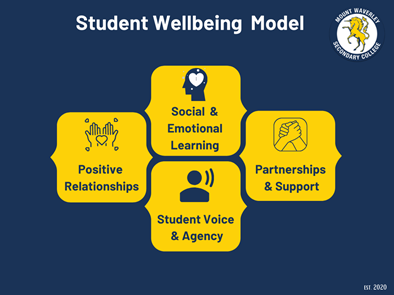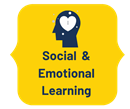Student Wellbeing Model
Mount Waverley Secondary College Student Wellbeing Model is a commitment to help students be happy, healthy and thrive.
We acknowledge for students to get the best out of themselves we need to focus on:
- developing positive relationships
- teach them social and emotional skills,
- encourage student voice and agency and
- to create strong partnerships with our families and community whilst providing our students with professional support.
History:
In 2017, MWSC participated in a school review process lead by the DET. This process highlighted several areas of improvement for student wellbeing. The findings of the review helped form the School Strategic Plan 2018-22. One of the three goals developed was to improve the wellbeing and resilience of all students. There were three key improvement strategies created including 3 a) Develop and implement a whole school approach to student wellbeing.
In 2019, a sub committee of MWSC staff led by Paul Graham (Manager of Student Wellbeing) was formed to commence the process of developing a student wellbeing model. Between 2019 and 2020, the sub committee completed the following research:
- Consultation with MWSC staff- identifying current strengths, areas of improvement and what aspects they deemed important when developing a whole school approach.
- Research of current models and frameworks including, School Wide Positive Behaviour Support Model, Australian Student Wellbeing Framework, Prospore (Framework for Positive Education) and FISO (Framework for improving student outcomes).
- Analysis of current date including, Attitudes to school survey data and the resilient youth data.
- Consultation with other schools who have been leaders in the delivery of Student Wellbeing- Carey Baptist, Cranbourne East and Balwyn High School.
- Led student focus groups- year 7 to 12, seeking feedback on student wellbeing
- Research into developing a whole school approach- Literature review ‘Building Resilience in Children and Young People’- 2013 University of Melbourne.
In 2020, during lockdown in Victoria, the Student Wellbeing Model was developed. The four key areas were identified as strengths within MWSC and areas for improvement. Underpinning the four key areas are four clear expectations of best practice. The best practice helps guide the goals and targets we set ourselves to help achieve our strategic goal to improve the wellbeing and resilience of all students.





